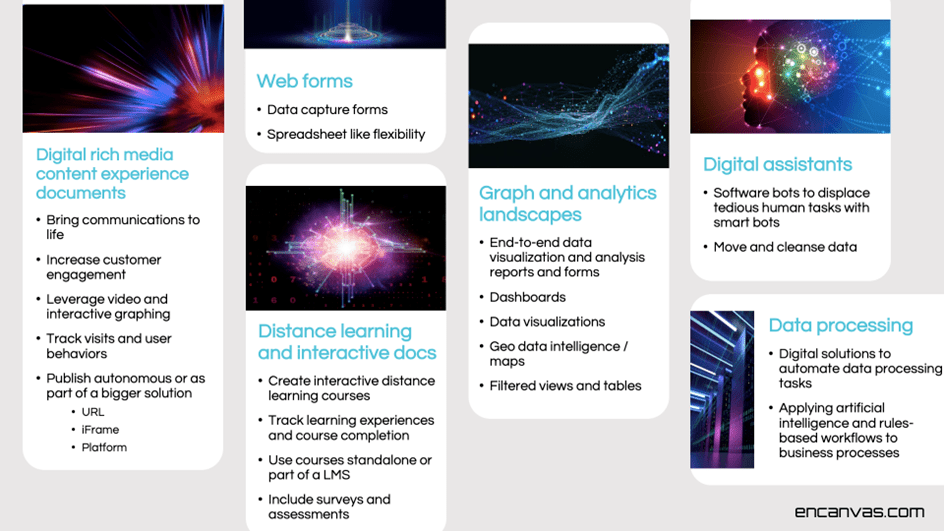Rapid-application development (RAD) is a term used to describe any form of adaptive approach that speeds up the process of creating and deploying software applications.

What can you do with digital documents?

Digital documents are a revolutionary tool enabling digital transformation for businesses. Discover some of the types of digital documents you can create using Encanvas.
Rich Media Content Experience
Content experience documents are all about engaging audiences in more impactful ways. A digital brochure (or eBook) combines rich media to produce persuasive, professionally crafted digital content. Rich media content—containing elements such as videos, testimonials, facts presented through interactive graphics, visualizations, etc.—increases stakeholder engagement, and improves customer experience, maximizing information consumption and use.
According to research into the opinions of 538 digital marketers conducted by Lemonlight in 2021, 81% plan to include video content in their marketing strategy over the next several years, while 94% said watching video content has helped them make a purchase decision at least once. Of those, 72% were swayed by a product video.
Distance Learning Courseware
Distance learning has transformed education. Digital courseware makes it faster and easier for courseware designers to design and publish courses. Furthermore, once published, digital courseware is a lot easier to update. One of its advantages comes from the ability to track learning journeys; sometimes, recording training and training results is essential for compliance.
Digital documents bring distance learning course development into the digital age. Take existing PowerPoint courseware and upgrade it to digital online courses in minutes. Use courses stand-alone or leverage an eLearning platform to manage them.
Web Forms
Web forms are another digital document example, as they’re used to capture data from customers and turn back-office processes into self-service experiences. Automating processes in this way not only improves customer experience by making more services on-demand but also increases customer engagement while reducing service costs.
Often, human-in-the-loop processes are re-engineered with the minimum amount of effort or fuss. Having captured data, workflow rules can be automated by software bots that also track and record customer interactions into Customer Data Platforms.
We’ve made forms integration with websites simpler too. Using Encanvas digital documents, web forms can be implemented as stand-alone solutions or be closely integrated with existing data repositories. Publish forms as secured permissions-based iFrames within existing websites, or link to public or private forms using dedicated URLs for direct access.
Digital Assistants
Software bots are great at recording transactions, making ‘micro-decisions’ across the enterprise, for harvesting and cleansing data, and moving it between locations. Many of the tedious tasks previously performed by humans and spreadsheet-powered data processing applications can be displaced by enterprise-grade IT solutions made possible by digital documents.
Spreadsheet Replacement and Micro Task Automation
While spreadsheets are versatile, they’re also labor-intensive. Give your knowledge workers more time to deliver value to customers and make a positive impact on innovation and business improvements by displacing spreadsheet apps with enterprise-grade digital document solutions. Our digital documents are powered by robots. That means, much of the heavy lifting that humans have previously done to capture, process, manage and analyze data can be discharged by software bots through automation.
Information Bridging GlueWare
Is your eCommerce front-end website fully automated with back-end systems? If so, then you’re ahead of the curve! Most organizations have a portion of their back-office data processing that goes ‘offline.’ This adds costs to service delivery costs while delaying customer requests and responses. Bottlenecks emerge and customer experience decays. The alternative is to use digital documents to bridge between systems and processes to create a ‘fully digital’ environment. The ability to leverage digital technologies to dramatically escalate time to value for digital transformations is increasingly being described as hyper-automation.
Data visualization
The possibilities to present and make sense of data using rich data visualization tools have grown dramatically thanks to innovations in cloud computing and big data tooling. Visualizations might come in the form of interactive maps used to track assets, parcels, people, vehicles or drones, or spatial charts and graphs that highlight key data attributes that would otherwise remain hidden to users.
Data processing
Arguably, the single biggest reason businesses invest in enterprise IT is to formalize and automate processes. Not so long ago, the way to do this was to invest in Systems of Record (SoR)—like Oracle, SAP, and Microsoft—that promised best practice data processing ‘templates’ that catered for the majority need and offered the assurety of robust and resilient data management and processing.
Related content
Rapid Application Development
Digital documents and analytics
Every digital business is driven by data. How are digital documents transforming accessibility to the insights executives and information workers need? We investigate.
No Results Found
The page you requested could not be found. Try refining your search, or use the navigation above to locate the post.




 This document highlights five major reasons to invest in an enterprise platform like Encanvas that supports the lifecycle of digital documents.
This document highlights five major reasons to invest in an enterprise platform like Encanvas that supports the lifecycle of digital documents.